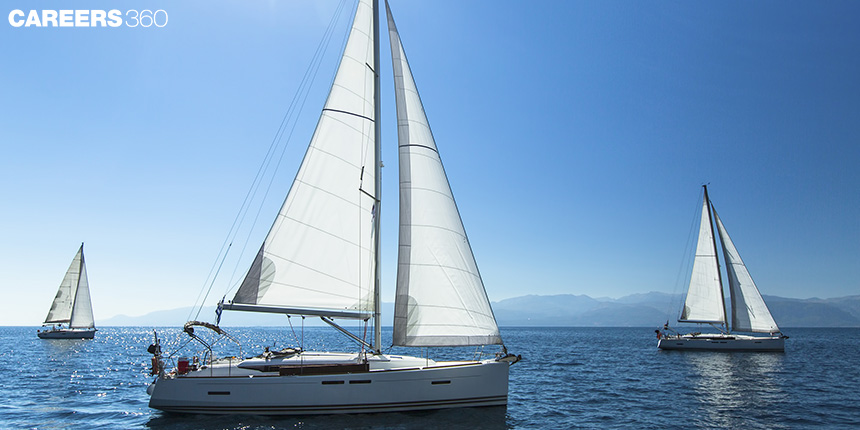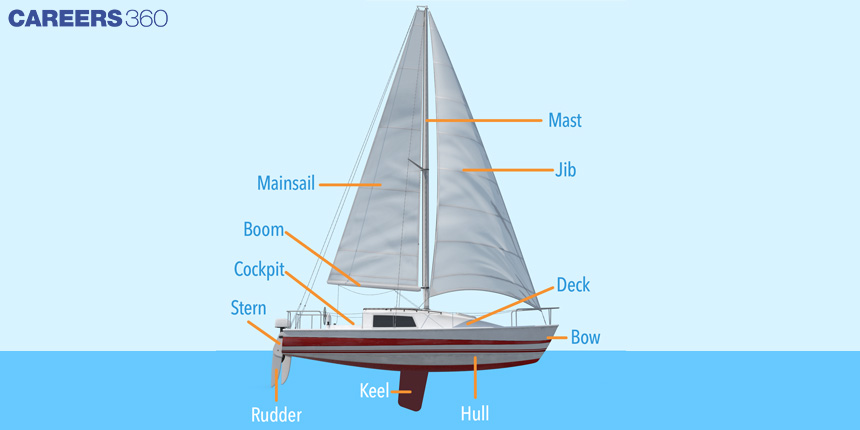Sailboats And Principles Of Physics, Understand the Science Behind Sailing
Sailboats have been a means of transportation and a source of recreation for thousands of years, and continue to be an enduring symbol of human ingenuity and innovation. But behind the graceful and serene movement of a sailboat lies a complex interplay of physical principles that make sailing possible. From the curious phenomena of Bernoulli's principle to the laws of motion that govern the movement of sailboats, to the intricate balance of forces and fluid dynamics that shape a sailboat's movement, we will go into the fundamental physics that underpins sailboat operation.

Parts Of Sailboat
Let’s first learn the parts of sailboats. Sailboats are made up of several parts that work together to enable the boat to move through the water using the power of the wind. Here are some of the main parts of a sailboat:

Hull: The hull is the main body of the boat, which is usually made of fibreglass, wood, or metal. It is designed to be buoyant, so it can float on the water.
Deck: The deck is the flat surface on top of the boat's hull where the crew stands or sits. It is usually made of wood or fibreglass.
Mast: The mast is a tall, vertical pole that is used to support the sail. It is usually made of aluminium, wood, or carbon fibre.
Boom: The boom is a horizontal pole that is attached to the bottom of the sail. It is used to control the shape of the sail and to help the boat turn.
Rigging: The rigging is the system of ropes and wires that support the mast and control the shape of the sail. It includes the shrouds, which are the wires that hold the mast up, and the halyards, which are used to raise and lower the sail.
Keel: The keel is a long, heavy fin that is attached to the bottom of the boat's hull. It helps to keep the boat upright in the water and provides stability.
Rudder: The rudder is a flat, vertical piece of metal or fibreglass that is attached to the back of the boat. It is used to steer the boat by changing the direction of the water flow around the keel.
Tiller: The tiller is a handle that is attached to the rudder. It is used to steer the boat by moving the rudder from side to side.
These are some of the main parts of a sailboat, but there are many other components and accessories that can be added depending on the type of boat and its intended use.
Also check - Supply And Demand: A Mathematical Analysis Of Market Equilibrium
Physics Of Sailboat
The physics involved in the working of sailboats can be quite complex, but the basic principles are relatively straightforward. Sailboats depend on wind energy to propel them forward, and the sails are designed to capture as much of that energy as possible.
Here are some key physics concepts that are involved in the working of sailboats:
Bernoulli's principle: This principle states that as the speed of a fluid (in this case, air) increases, its pressure decreases. The shape of the sail is designed to take advantage of this principle, by creating a curved surface that causes the air moving over it to travel faster than the air moving below it. This creates a region of lower pressure above the sail, which generates lift and propels the boat forward.
Newton's laws of motion: These laws describe the relationship between an object's motion and the forces acting on it. In the case of a sailboat, the force of the wind pushing against the sail creates a forward force (known as thrust) that propels the boat forward. The water pushing back against the boat (known as drag) slows it down, but the boat's keel or centreboard can counteract this by generating a sideways force (known as lift) that keeps the boat moving forward.
Centre of effort and centre of resistance: The centre of effort is the point on the sail where the force of the wind is concentrated, while the centre of resistance is the point on the boat where the water resistance is concentrated. These points need to be balanced in order for the boat to sail efficiently and maintain its course. If the centre of effort is too far forward, the boat may heel over too much and become unstable; if it's too far back, the boat may not be able to sail upwind effectively.
Apparent wind: The wind that a sailboat experience is not the same as the actual wind blowing over the water. Instead, it's a combination of the actual wind and the boat's own motion through the air (known as its apparent wind). This apparent wind can be different from the actual wind in terms of direction and speed, and the sails need to be adjusted to take this into account.
Overall, the physics of sailboats involves a complex interplay of forces and fluid dynamics, but understanding the basic principles can help sailors optimise their performance on the water.
Also check - From Pixels To Pictures: What Is The Math Behind Digital Image Processing?
Applications for Admissions are open.
As per latest syllabus. Physics formulas, equations, & laws of class 11 & 12th chapters
JEE Main Important Chemistry formulas
Get nowAs per latest syllabus. Chemistry formulas, equations, & laws of class 11 & 12th chapters
JEE Main high scoring chapters and topics
Get nowAs per latest 2024 syllabus. Study 40% syllabus and score upto 100% marks in JEE
JEE Main Important Mathematics Formulas
Get nowAs per latest syllabus. Maths formulas, equations, & theorems of class 11 & 12th chapters
